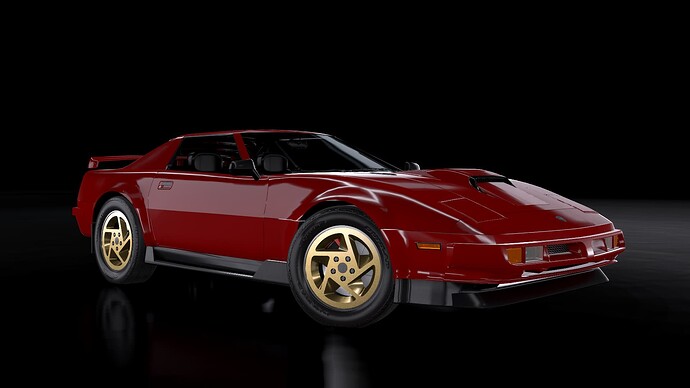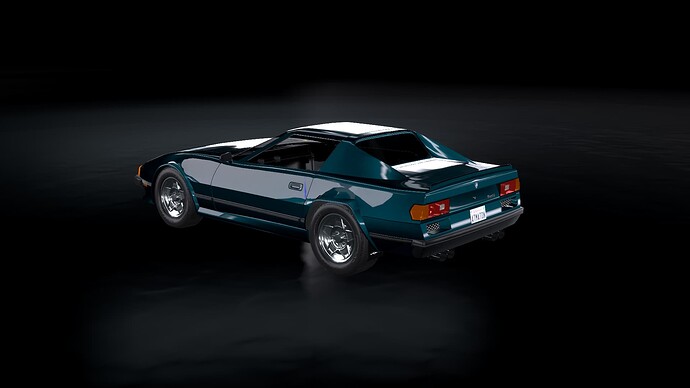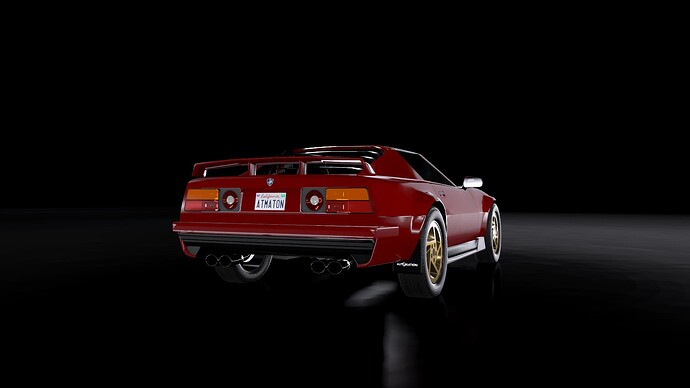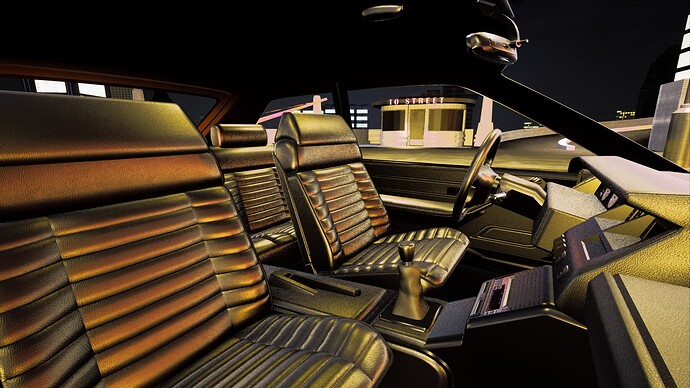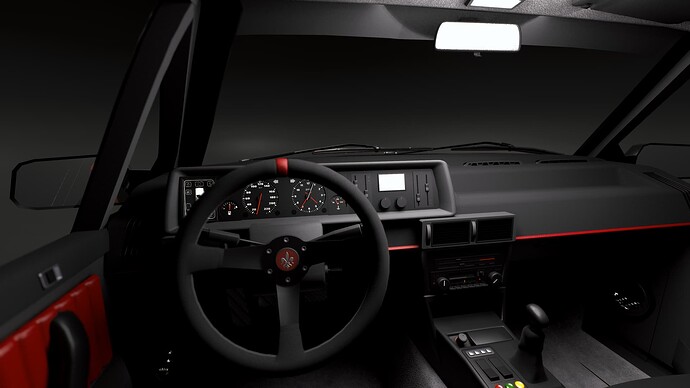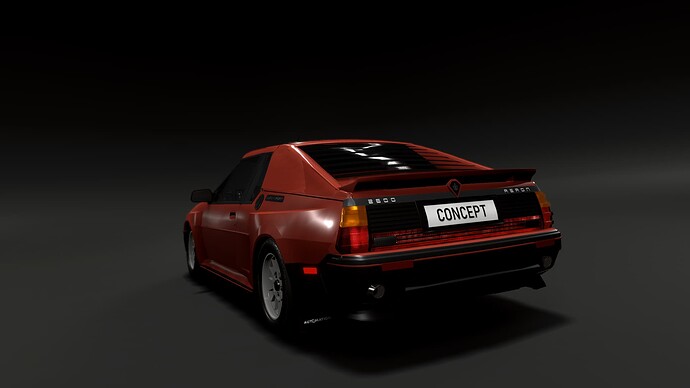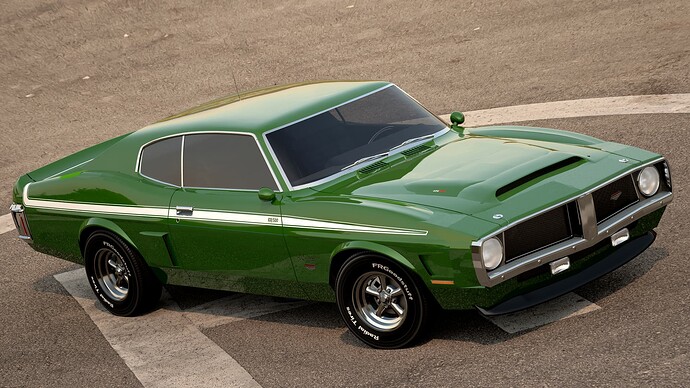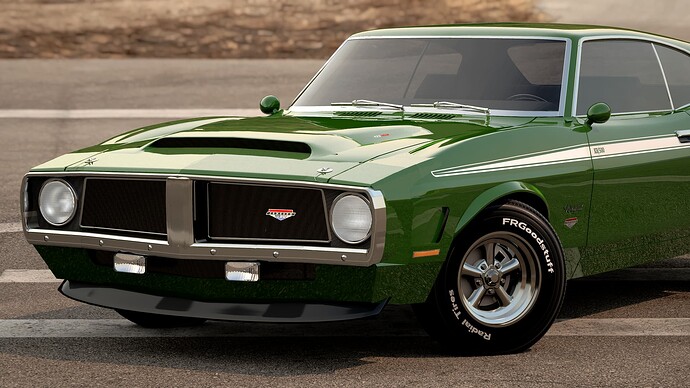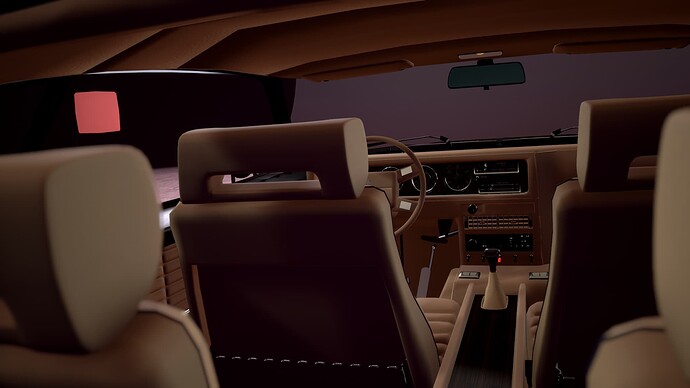It’s strange that a car with so little power could reach such a high speed… It could be the result of fitting a fully clad undertray (the slipperiest one available) and lowering the downforce levels to their absolute minimum.
I was right about it having an undertray, but as you’ve just shown, it was the semi-clad (rather than the fully clad) variety. So the top speed figure turns out to be a heavy investment in aero quality (+5) and a reduction in brake cooling airflow to the absolute minimum.
1992 KVT Omertosa GT
Once this baby hits 188 mph, You’re gonna feel some serious shit.
The all new and all aluminium 1992 Omertosa GT comes standard with it’s high trim 3.6L V8 pushing out 290 hp. It might not seem a lot for what it is but rest assured that it is enough power to push this light weight 1108 kg body from 0 to 60 in 4.1 seconds and happily cruise at a top speed of 190 mph.
1992 Fujimi R300 GT-4 Turbo
With all-wheel drive, all-wheel steering, electronic traction control and a turbocharged inline-six engine with variable valve timing and lift, the R300 GT-4 is the pinnacle of Japanese engineering and technology. Further tuned for the American market, it gets a bigger turbocharger and an upgraded exhaust system, increasing power output to 368 hp.
The R300 is a brutish JDM sports coupe in a sea of Western GTs and supercars… and yet it doesn’t look even remotely out of place in such exalted company. I could easily imagine an even more highly tuned version of one of these rampaging along the Wangan Expressway or the Hakone Turnpike back in the day.
It’s interesting to note that both your entry and mine (the Antares GT) are based on some variant of the '92 Evade body set, but I chose the 2.65m wheelbase variant in notchback configuration (which lacks a wraparound rear window and instead has an obvious C-pillar), whereas the R300 is based on a fastback variant (which, by default, has a wraparound rear glass window but lacks a discernible C-pillar, although the extra photos show that you made it look like the rear glass is comprised of three different panels).
And whereas the Antares GT reminds me of the offspring of an X100 XK8 and a DB7 (especially with a front end reminiscent of the former, and taillight lenses shaped like those on the latter), your R300 makes me think of what a Z15A/Z16A 3000GT would have looked like if it had a longitudinally mounted inline-six instead of a transverse V6 - but I find your take on an entry for this challenge just as appealing as the one I eventually settled on.
SVETSON  presents:
presents:
The Svetson FalkN!
Using an all aluminum, naturally aspirated, 3.4L V6 that produces 320HP which is then paired with an advanced automatic transmission that sends power to all 4 wheels with immense force.
This Swedish beast can go from 0-60 in 5.84 seconds and reach a top speed of 178MPH, doing all of this while being able to attain a mileage of 21.6MPG. Not to forget, with all this insanity, sitting inside, you’ll be greeted by the finest leather that’ll flatter fashion designers all around the world.
This Swedish piece of insane yet sensible machinery for $44,400.
We heard that you were looking for a little something with character…
Carcharhini is please to introduce you there 92 Special Edition Recif:
Based on our 1980 Recif GTS this special edition see its 5.5L Bronco V10 pushed to 370hp propulsing this 1,5 tonnes beast from 0 to 100 km/h in 4,5 sec.Of course, the improvements are not limited to the engine. It has benefited from a complete facelift: the front and rear have been totaly redesigned, offering a better aero and providing better cooling.
This can be yours for less than $34k. Who said pleasure can’t be cheap?
If you need more, comme and take a ride:
BeamNG Drive Mod
Gallery







Riegler Solis Turbo V6
“Riegler” is a high-performance aftermarket tuning company founded in Neuss, Germany in 1977. After gaining a strong reputation with their “Margarete” sedans modifications during the 80s, Riegler spread its range to Luxury and GT cars from “Waddser” and other european manufacturers.
“Waddser” is a french manufacturer who first released their “28 Series” platform in 1974 with the GT model “Solis”.
It featured a monocoque chassis with aluminium body panels and double wishbone suspension all around, an advanced all aluminium V6 with OHC, forged components, mechanical fuel injection and tubular headers. It came with a manual 5 or automatic 3 transmission linked to a clutched LSD driving the rear wheels. It had radial tyres, alloy rims, solid discs all around, assisted rack and pinion steering and a high-end interior.
The fourth generation Solis released in 1986 and featured then a multipoint EFI, a smoother helical LSD, vented discs, a whole new safety system including ABS and a cassette player. Waddser also offered the “Solis Turbo”, built to be cheaper and more attractive to young people with its inline 4 and overall lighter premiumness.
For their 1992 project, Riegler chose to heavily modify a 1986 Waddser Solis V6 manual. Waddser offered a turbo for their inline 4, why not for their V6 ? So they went into work :
They drilled meticulously placed holes in the chassis, making it lighter and stiffer, added a single 90mm turbo on top of the V6 blowing at 0,8 bar and made a custom performance intake. The engine is capable of 380 hp at 5200 RPM and 580 Nm at 4400 RPM, being above 500 Nm between 2500 and 5400 RPM, and somewhat reliable.
Wide custom wheels have been fitted to accommodate the power gain, and a custom hood has been made for the turbo to fit, making the car a lot more aggressive, especially with its heavy aero bodywork.
They fitted a CD player from Paonner along with a new high quality leather seat covering, a new steering wheel and sportier white gauges.
New plastic bumpers, door handles, high quality seatbelts, airbags and electronic safety organs have been added to make the car very safe in a typical german manner, rearranging the overall weight distribution towards the car’s center of gravity.
Overall, the car shows excellent performance, with a 0 to 62 mph in 5,0 seconds, above 160 mph top speed (260 km/h), a 62 to 0 mph in less than 38m, and it is capable of 1g overall during cornering, although there is still a handful of wheelspin to play with in 1st or 2nd gear.
1984 Octane Aeron 2600 SUPERSPORT
When released as a group B contender in the early 80s by Régal Auto, the Aeron received a lot of acclaim for it’s peppy SOHC 3.0L 6-cylinder engine, good handling, lightness and performance in race and rally.
In '84, Octane, Régal’s motorsport/tuner brand, decided to put its hand on the Aeron and give it a special treatment. The engine was totally rebuild from scratch on the same block parameters and dimensions, but with a brand new lightweight aluminum block, now tuned for high RPM on only 2.6L. With a brand new variable valve timing intake system, double cam and forged components, it could technically rev to 10,000 RPM now, but Octane kept this GT version down to a 7800 rpm redline. Using an upgraded MPEFI, Octane invested heavily in independent throttle bodies coming from their racing division, on a fuel rich performance intake. While the 240hp figures did not seem very high, this edition ended up around 1175kg (nearly 200kg less) for a 5 seconds 0-60 and a top speed of 169 mph.
The car was given track improvement, with lowered suspension, a weight diet, better front aero, bonnet intakes and better cooling vents. Staggered wheels were installed with performance sport compound and a larger brake kit installed. Finally, lightweight bucket seats and sport interior were installed, keeping the 2+2 configuration. Many components were kept compatible, like the 5-speed manual transmissions, but were rebuilt with performance parts - the viscous LSD, ABS and hydraulic rack & pinion were retained but tuned. Suspension was fully modified for performance and handling, with a highly cambered and toed setup, keeping the car firmly on the tarmac.
1987 Wells GTC
When it comes to the ultimate level of luxury and performance, there is none other.
GTC, from Wells.
SPECIFICATIONS
- Type: 2dr coupe / 4pax
- W.B: 2730mm / L: 4650mm / W: 1900mm
- Configuration: Front-engine, longitudinal all-wheel-drive, Ferguson Formula
- Suspension configuration: Double wishbone / Double wishbone
- Curb weight: 1437kg
- Engine & transmission: DOHC 24V v12, naturally aspirated, 6497cc, Bosch K-Jetronic mechanical fuel injection / 5-speed manual transmission
- Power: 417hp@5000rpm / 618.9nm@4600rpm
Price as configured: 45,000AMU
INFORMATION
The Lumiere Alphecca was first unveiled to the world as a proof-of-concept at the Gasmea Luxury Expo of 1973. It was, at the time, a one-off proof-of-concept built atop the architecture of an existing Clari platform, retrofitted with an AWD system similar to and likely based upon that of the Jensen FF of seven years prior, with a similarly rear-biased split of 31/69. This was deemed necessary because unlike the base car which made do with a V8, the Alphecca in show form was powered by a 7-litre, quad-valve, electronically-injected, dual overhead camshaft V12 that made 520.6 horsepower and 677.6 newton-meters of torque at the crank. This, when paired with a 4-speed automatic gearbox, was enough to propel the grand tourer to 62mph in 4.8 seconds, and on to a top speed of 192mph. At the time, this made it the single fastest car in the world bar none— and it was a four-seater grand tourer with a full hand-crafted interior riding on hydropneumatic suspension. It was so ridiculous that scarcely anyone believed it would hit production— certainly not in the exact same specification.
The production-specification Lumiere Alphecca Series I was launched in 1975, looking almost visually unchanged from the show car— though the original two-tone color scheme and gold-plated trimpieces were relegated to expensive optional extras. For certain markets, the car was sold with color-matched crash bumpers. The bulk of the transitional changes could be found under the skin— the original 7-litre was deemed too expensive to produced and was summarily downbored and downgraded to a 6.5-litre twin-valve unit fed by a Bosch K-Jetronic mechanical injection system. The production-specification unit made 412.7 horsepower and 612.7 newton-meters at the crank— a loss of nearly 110 horsepower and 65 newton meters of torque. Despite this, however, when paired with the standard five-speed manual transmission and driving all four wheels, the V12 “α” trim was still able to reach its vaunted top speed of 192 miles per hour— and in fact the 0-62 sprint would be cut down to a scant 3.8 seconds. Despite all these virtues, however, it never sold very well— in considerable part because despite being tamed for production the car made more power than the wheels could put down, but also because at launch the V12 α retailed for well over 50,000 AMU. Most customers simply opted for the “considerably less lairy” V8 β.
The Alphecca Series I would continue to be produced until 1982. Late-models were fitted with anti-lock brakes, making the car considerably easier to drive, but by then it was too little too late. Financial difficulties going into the 80s meant that the Alphecca would not be succeeded until 1994.
ATELIER HERITES
Atelier Herites is an initiative launched by Lumiere of 1992 to provide extended support to owners of older-model vehicles of at least ten years of age or older. As the name suggests, it is an in-house workshop that primarily works with older cars, making use of original manufacturer resources to refresh these vehicles back to showroom condition with carefully-chosen upgrades when applicable to make them more livable in the modern day.
In the case of this 1977-model Series I Alphecca— and indeed, with any eligible Series I Alphecca, the changes are minimal and unintrusive. The engine sees a full teardown service, with every part refurbished in one way or another or replaced with brand-new original specification parts manufactured to modern standards— the result is an engine of greater reliability than the one it left factory with, whether it be a V8 or the V12. To accompany this rebuild, a new high-flow exhaust system is installed, increasing the engine’s output to 417 horsepower and 619 newton-meters. A big-brake kit is installed, along with anti-lock braking if the car did not already have it. Modern sports-compound tires, specifically ordered to fit the OEM wheels are fitted to further improve handling characteristics. Variable power steering is retrofitted in place of the original hydraulic pump to improve control at high speeds— necessary as the car in its refurbished form now reaches a top speed of 201mph. In the interests of safety, driver and passenger-side airbags are retrofitted. A modern cassette-compatible sound system is installed in place of the old 8-track player.
The cost of all this work varies based on the condition of the original car. However, if the customer so wishes, Lumiere Atelier Herites will also attempt to track down an example of any given Herites-eligible model to refresh and sell to you as a new purchase— a Series I Alphecca V12 α acquired this way is expected to cost at least 46,000 AMU.
This car was originally created for ATC3. Special credits to @knugcab for the interior work.
Dear Entrants,
Due to unforeseen circumstances (think of it also as an advanced birthday present since my birthday is closing in), the deadline is extended to the 2nd of February and you will be given permission to resubmit once for any reason.
Sorry for the inconvenience.
Sincerely,
“Unknown”
Due to unforeseen circumstances (think of it also as an advanced birthday present since my birthday is closing in), the deadline is extended to the 2nd of February and you will be given permission to resubmit once for any reason.
Sorry for the inconvenience.
Sincerely,
“Unknown”
For anyone wanting to resubmit, must they do so on the DM thread that contained the original submission? I’m pretty sure they have to.
Anyway, the entry list is indeed filling up right now - with all manner of entries from muscle/pony cars and JDM sports coupes to actual grand tourers and even mid/rear-engined supercars. It’s a sure sign you got the ruleset right after all.
Take two, I’ll learn how to format eventually.
The Ceith 208
Gallery
Split into separate posts because I cant make decent imbeds
Specs
Closing statments and aditional information
CMG, also known as Chief motor group is a small tuning garage based out of the east cost. The opertunity to give your main characters a personalized touch to any classic car is our specialty, and we wish to share that with you. If any additional information or referace images are needed, please dont feel afraid to contact us. The Ceith 208 is based off a wecked european box, the title is orange.
.95G - 200m cornering
0.206 - Power to weight
58/42 - Weight distribution
208mph - Top speed
6 speed manual - Gearbox
123ft - 60-0 Breaking distance
Hi! I’m very new to this site and I joined the Discord server recently. There I found this challange and wanted to participate. How do I send in my entry? Do I upload images here in the replies? Thanks for any answers! ![]()
Both
You make an ad here (just posting a few pics and the car’s name is usually enough) and you dm the .car file to the host

















